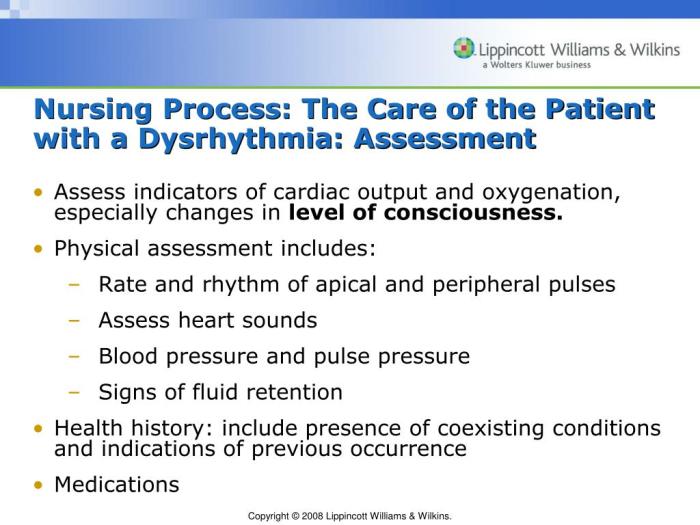Nursing care cardiac dysrhythmias edapt – Delving into the intricacies of nursing care for cardiac dysrhythmias, this comprehensive guide empowers nurses with the knowledge and skills to effectively manage these conditions. Exploring the full spectrum of nursing interventions, from early recognition and assessment to emergency management and patient education, this resource equips nurses with the tools to optimize patient outcomes.
Understanding the complexities of cardiac dysrhythmias is paramount for nurses, as their early recognition and prompt intervention can significantly impact patient prognosis. This guide provides a systematic approach to assessing and managing various dysrhythmias, empowering nurses to make informed decisions and implement appropriate interventions.
1. Nursing Care for Cardiac Dysrhythmias

Cardiac dysrhythmias are disturbances in the electrical impulses that control the heart’s rhythm. They can range from mild and asymptomatic to life-threatening. Early recognition and intervention are crucial to prevent complications and improve patient outcomes.
Assessment Findings
- Palpitations
- Chest pain
- Shortness of breath
- Lightheadedness or dizziness
- Syncope (fainting)
- Edema
Nursing Interventions
- Monitor vital signs, including heart rate, rhythm, and blood pressure.
- Perform a thorough cardiac assessment, including auscultation of heart sounds and palpation of peripheral pulses.
- Administer medications as prescribed, such as antiarrhythmics, beta-blockers, and calcium channel blockers.
- Provide emotional support and reassurance to patients and their families.
- Educate patients about their condition, medications, and lifestyle modifications.
- Assess the patient’s condition and determine the type of dysrhythmia.
- Initiate life-saving measures, such as cardiopulmonary resuscitation (CPR) and defibrillation.
- Administer medications, such as amiodarone, lidocaine, and adenosine.
- Monitor the patient’s response to treatment and adjust interventions as needed.
- Communicate with the healthcare team and consult with physicians as necessary.
- Description of the patient’s dysrhythmia and its potential risks.
- Explanation of medications and their side effects.
- Lifestyle modifications, such as diet, exercise, and stress management.
- Importance of follow-up care and regular monitoring.
- Resources for support and information.
2. Emergency Management of Cardiac Dysrhythmias
The emergency management of cardiac dysrhythmias requires prompt and decisive action to prevent serious complications. Nurses play a critical role in assessing, monitoring, and intervening in these situations.
Nurse’s Role, Nursing care cardiac dysrhythmias edapt
3. Education and Patient Care

Patient education is essential for the successful management of cardiac dysrhythmias. Nurses have a responsibility to provide clear and comprehensive information to patients and their families.
Key Components of Patient Education
Common Queries: Nursing Care Cardiac Dysrhythmias Edapt
What is the primary role of nurses in managing cardiac dysrhythmias?
Nurses play a vital role in early recognition, assessment, monitoring, and intervention for patients with cardiac dysrhythmias. They are responsible for implementing prescribed treatments, providing patient education, and collaborating with other healthcare professionals to ensure optimal patient outcomes.
How can nurses effectively manage cardiac dysrhythmias in emergency situations?
In emergency situations, nurses must remain calm and follow established protocols for managing cardiac dysrhythmias. This includes assessing the patient’s condition, administering medications, and performing interventions such as defibrillation or cardioversion as necessary.
What are the key components of patient education for cardiac dysrhythmias?
Patient education is crucial for empowering individuals to manage their cardiac dysrhythmias. Nurses should provide information about the condition, its symptoms, triggers, and treatment options. They should also emphasize the importance of lifestyle modifications, medication adherence, and regular follow-up appointments.